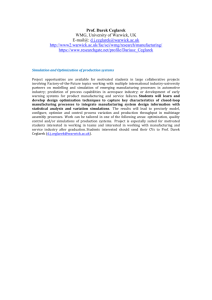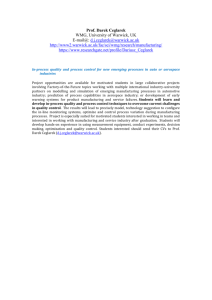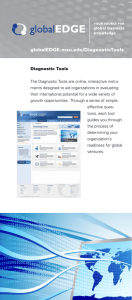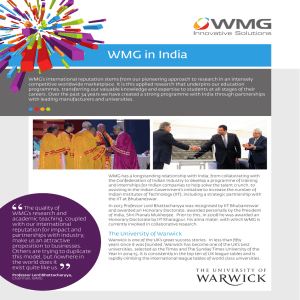IARC Projects Case Study Template
advertisement
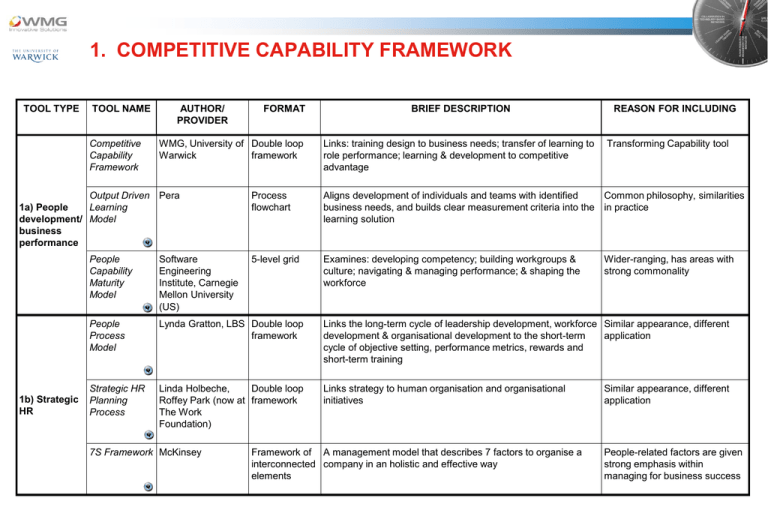
1. COMPETITIVE CAPABILITY FRAMEWORK TOOL TYPE TOOL NAME Competitive Capability Framework AUTHOR/ PROVIDER WMG, University of Double loop Warwick framework Output Driven Pera Learning 1a) People development/ Model business performance 1b) Strategic HR FORMAT BRIEF DESCRIPTION Links: training design to business needs; transfer of learning to role performance; learning & development to competitive advantage REASON FOR INCLUDING Transforming Capability tool Process flowchart Aligns development of individuals and teams with identified Common philosophy, similarities business needs, and builds clear measurement criteria into the in practice learning solution 5-level grid Examines: developing competency; building workgroups & culture; navigating & managing performance; & shaping the workforce People Capability Maturity Model Software Engineering Institute, Carnegie Mellon University (US) People Process Model Lynda Gratton, LBS Double loop framework Links the long-term cycle of leadership development, workforce Similar appearance, different development & organisational development to the short-term application cycle of objective setting, performance metrics, rewards and short-term training Strategic HR Planning Process Linda Holbeche, Double loop Roffey Park (now at framework The Work Foundation) Links strategy to human organisation and organisational initiatives 7S Framework McKinsey Framework of A management model that describes 7 factors to organise a interconnected company in an holistic and effective way elements Wider-ranging, has areas with strong commonality Similar appearance, different application People-related factors are given strong emphasis within managing for business success 2. INNOVATION READINESS AUDIT (1) TOOL TYPE TOOL NAME FORMAT BRIEF DESCRIPTION REASON FOR INCLUDING WMG, University of Semi-structured Warwick interview and report Evaluates a company’s people development process capability, related to the Technology Transfer Cycle Transforming Capability tool Real World Group Staged set of questionnaires Diagnostic tools for organisational and individual development. Topics include organisational culture, readiness for change, leadership behaviours, management competencies Similar style, but wider ranging Change Readiness Diagnostic Roots Shoots Fruits Web-based survey Enables understanding of the level of readiness for change, and covers various areas including customer and employee surveys. It comprises a standard question set with ability to add additional ones specifically relevant to a situation Similar in nature, but for general change and transformation Business Review and Action Plan Business Link West Six part Through SWOT analysis develops recommendations for business Midlands questionnaire and improvements, covering products, services, operational systems and action plan processes, and gap analysis of people and financials worked out with BL advisor and company Similar approach, different focus Best Business Practice – People and Skills Module DTI, delivered through the national business link network Innovation Readiness Audit Real World 2a) Readiness Diagnostics for Change 2b) Business AUTHOR/ PROVIDER Online staged questionnaire Objective review of learning and development strategy, covering recruitment, workforce development, performance management Similar approach, more of an HR emphasis Flexible user driven software tool Provides the capacity to build a company’s own system of skills diagnosis and training regimens. Related topic, with more of a skills emphasis 2c) Skills in General Skills Gap MyKnowledgeMap Analysis Competency Management 2. INNOVATION READINESS AUDIT (2) TOOL TYPE TOOL NAME On-Line CPD Scheme AUTHOR/ PROVIDER Chartered Management Institute FORMAT BRIEF DESCRIPTION REASON FOR INCLUDING Online self assessment tool Focuses on Business Impact, CPD and 360-Degree Related topic, though rather short assessment to evaluate Chartered Manager and focused on management potential training Managerial Development Assessment Of Processes Proficiency Group 2d) (Map) Tool Leadership & Management Self-diagnostic tool and consultant facilitators Benchmarks the competence of management Very popular tool – accepted by teams against 12 generic competencies, 2 AWM. Focused on management management styles and 8 personal/communication training styles/values. Developing Management Skills for Europe Book. Series of steps in chapters (all start with a diagnostic tool) Practical guide/ diagnostics for effective managerial Thorough set of diagnostics, behaviour covering management skills, gaining more focused on individual skills power and influence, motivating others etc Web-based diagnostic toolkit Focuses on core knowledge & information roles Similarities to Transforming Capability diagnostic, though focused on knowledge and information assets Web-based document with staged questionnaires and explanatory information Focuses on seven areas for creating value: relationships, knowledge, leadership & communication, culture and values, reputation and trust, skills and competencies, processes and systems These intangibles are highly relevant to innovation and technology transfer Whetten, Cameron and Woods Knowledge and TFPL Information Skills Toolkit Critical Department of 2e) Trade and Knowledge & Success Factors: Industry Intangibles Creating Value from your Intangibles 3. BUSINESS IMPACT ANALYSIS & IMPLEMENTATION TOOL TYPE 3a) Measurement of Business Impact 3b) Learning Uptake 3c) Role of People in Business Success TOOL NAME AUTHOR/ PROVIDER FORMAT BRIEF DESCRIPTION REASON FOR INCLUDING Process Methodology which identifies business targets, the activities required to meet these targets & evaluates the business impact achieved as a result of their implementation Transforming Capability Tool Jack Phillips/ ROI Institute Inc Process Comprehensive measurement and evaluation system which collects measures of learning, business impact & ROI Similar philosophy & practice Metrics that Matter Knowledge Advisors Web-based tool Learning evaluation system which assesses effectiveness & quality of training - tool underpinned by Kirkpatrick & ROI methodologies Similar philosophy – different mode of application Productivity & Competitiveness (PAC) Framework SEMTA/ SMMT Industry Forum, LSC Process/ Framework Links training to organisational & operational changes yielding increased productivity that can be measured on the bottom line Similar philosophy & practice, particular focus Train to Gain LSC in collaboration with Process Business Link & IIP Identifies the skills a business needs, determines a tailored training package, finds funding & reviews progress Links training selection to business need Kirkpatrick’s Learning Evaluation Model Donald Kirkpatrick Evaluation Model Theory Model suggests that there are 4 levels of learning & training evaluation – reaction, learning, behaviour & results Widely recognised training evaluation theory Stake Congruence/ Contingency Model Robert Stake, University of Chicago Evaluation Model/ Process Provides a process which objectively compares & contrasts what was planned & what happened in a learning intervention Widely recognised training evaluation process Balanced Scorecard Robert Kaplan / Harvard Business School/ General Usage Framework Considers business performance relative to the vision and strategy in four main areas or ‘perspectives’: financial, customer, internal processes & learning & growth Links people performance & business performance EFQM Model Self European Foundation for Assessment Quality Management Framework Self assessment framework for measuring the strengths & areas for improvement of an organisation across all of its activities Links people performance & business performance Business Impact Analysis & Implementation WMG, University of Warwick Phillips ROI Methodology


